Pump Controller¶
Okay, so now that I have something to collect the heat from the sun, and a place to store the heat, how do I get the heat from one place to another? A pump, of course. Specifically, a 12 volt DC Sun-15 pump. This seems like a nice little pump, and it doesn’t use much electricity which is a definite plus. It doesn’t have a backflow check valve, which is also a plus in this situation because I want water to be able to fully drain out of the collector and back into the tank.
The pump’s job is to circulate water from the storage tank through the collector and back into the tank. I had to take some care to make sure the pump itself was well below the water inlet pipe; I initially tried mounting it about halfway down the side of the tank, but had some problems with the pump not staying primed. My initial attempt also had the water inlet pipe sucking water from the bottom of the tank, but the pump just didn’t have enough juice to pull the water all the way up and over the top edge of the tank that way. Moving the inlet to the top of the tank, and locating the pump all the way at the bottom seems to have solved these problems.
The pump didn’t come with a mounting bracket, so I just used a C-shaped plumbing clamp to hold it down on one side:
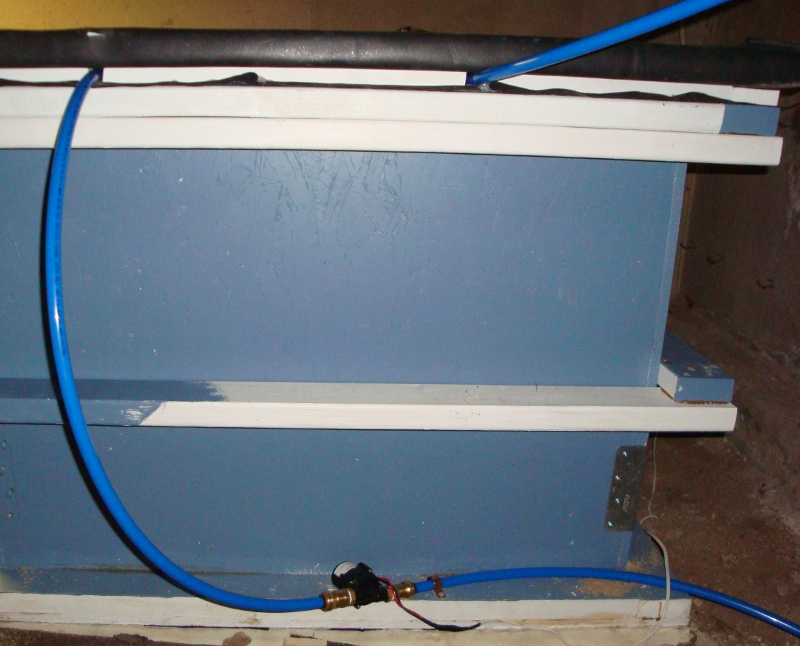
So you’ve got a pump, but when should you turn it on? You could put a thermometer in the collector, and manually switch on the pump when it’s sunny. Or, just run the pump directly from a photovoltaic solar panel–it would automatically pump whenever the sun is out. I wanted something with a little more control, and room for optimization. I don’t want to run the pump if my storage tank is already hot enough, and in the winter I expect there will be times where it’s sunny enough to drive the pump, but not sunny enough to heat up the collector significantly. It’s all about temperature.
What’s needed, then, is a differential controller–a sort of thermostat that can turn something on when the difference between two temperatures (in this case, the collector and tank) is some predetermined amount. You can buy several such devices off the shelf; the site where I got my pump has one such model. But I’m a computer programmer by trade; I wanted something I could customize and extend entirely to my liking.
So, I did some Googling, and ended up buying an Arduino Uno, a couple of DS18B20 digital temperature sensors, and a pile of other components that I would need for building two circuits:
- Pump relay circuit: Allows controlling the 12V pump from the 5V Ardino
- Sensor circuit: Reads temperature of both sensors from a single pin to the Arduino
I assembled these circuits on a small prototyping board, and wired it up to the Arduino, then mounted both of them to a small piece of wood that I can hang on the wall.
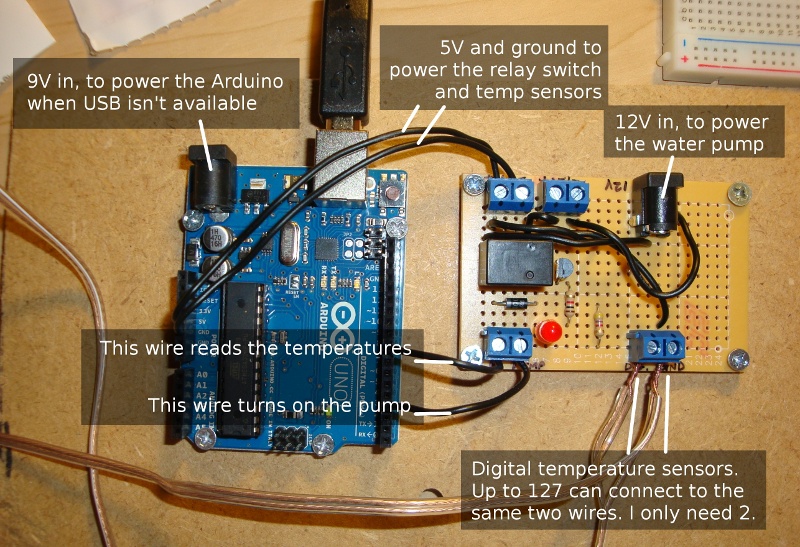
Here are the original schematics for the two circuits:
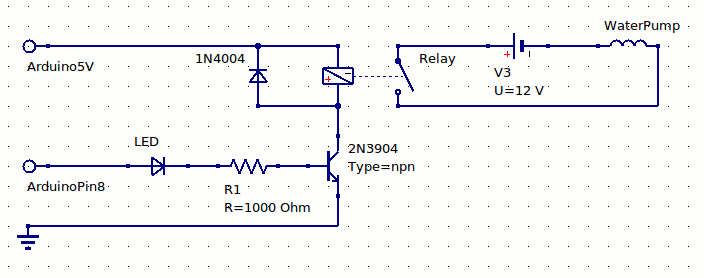
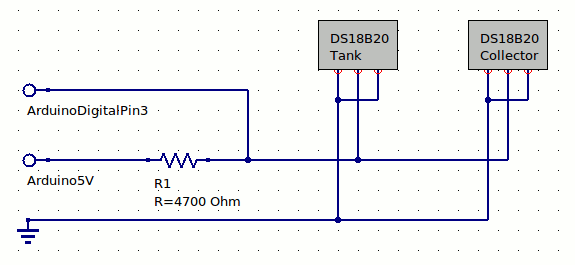
Later, I re-built the controller on a Proto-Screwshield, with an RGB LCD Shield atop it. Instead of an LED to indicate when the pump is on, I made use of the LCD backlight color: Red when the pump is on, blue when it’s off. It only took a minor modification to my controller software to enable it to display the collector and tank temperature on the LCD.
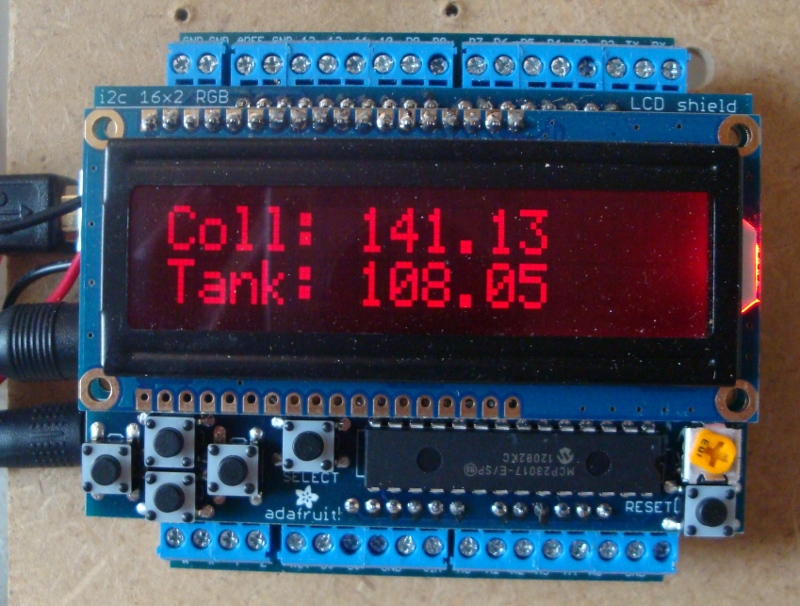
Instead of a relay switch, I used a Power MOSFET to turn on the pump. I had hoped that this would eliminate the bad temperature readings, but no luck on that front–I’m still getting the bad readings. Not really a high priority at this point, since it works so well otherwise.

The Arduino can execute whatever code you want, so all I had to do was write up a short C program with the logic I wanted to use for turning on the pump. This part is still a work in progress, but here’s basically how it works, with the decision-making going in this order:
- Collector too cold? If the collector is cold (below 40F), the pump is off. This handles the freeze protection; under no circumstances do I want to pump water through a freezing (or near freezing) collector. This takes the highest priority, since freezing could break my collector.
- Tank already hot? If the tank is already hot (above 140F), the pump is off. This is the safe upper limit I’ve decided to stick with in order to increase the life of the tank liner and PEX plumbing. Again, high priority because of the possibility of damaging something.
- Collector hot enough? If the collector is over 20F hotter than the tank, turn on the pump. This is a configurable threshold that is intended to prevent the collector temperature from dropping too rapidly when the colder water begins circulating. For example, if the tank is 70F and the collector is 90F, it makes sense to turn on the pump, but if the tank is 70F and the collector is only 80F, there’s not much to be gained by turning on the pump yet.
- Collector not hot enough? If the collector is less than 10F hotter than the tank, turn off the pump. I found that with less than 10F of difference, the tank might actually lose heat, so this is kind of a “quit while you’re ahead” threshold. Also, having a different off-threshold helps prevent the pump from cycling on and off too much.
- Otherwise... If none of these conditions applies, don’t change state. This only takes effect during the range between the two thresholds. For example, if the collector was hot (pump is already on), and is now cooling down, it may be 11F to 19F warmer than the tank. As long as it stays in this range, the pump will stay on, but as soon as the difference drops to 10F, the shut-off condition will be reached. It won’t turn on again until it hits the 20-degree differential.
Because of some glitches with my temperature sensors, I added one more condition, with the highest priority:
- If either sensor reads below -50F, ignore it.
I’m getting pretty frequent readings of -196.6 degrees from the sensors; it only happens when the pump relay is on, so I think it has something to do with the 5V being drawn to hold the relay switch closed, and not enough voltage getting to the sensors.
I’ve added my Arduino code, along with circuit diagrams and some other utilities as a Github project called ardiff, released under the MIT License, so feel free to use my code if you build something similar (and let me know how it goes!) I should mention that I am not any kind of electrical engineer; this was the first time I’ve ever soldered any significant circuitry, and I am still learning, so if you fry your Arduino or pump, don’t say I didn’t warn you.
Does it work? Well, see for yourself at Getting Results.